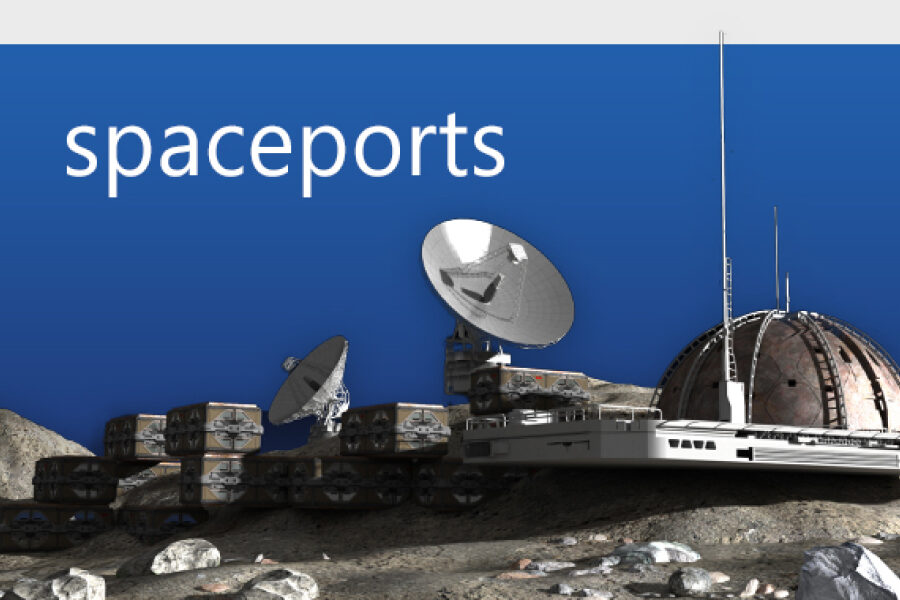Spaceports on the Moon: A Look Into the Future of Space

The idea of a lunar civilization has long inspired us to imagine what daily life may be like on the moon. But what is commonly overlooked while fantasizing about the future is the necessary path to get there.
This path begins with the first lunar spaceport, which will be crucial for the construction of a moon colony. The first spaceport will allow humans to land and launch from the same location, unlike the six crewed Apollo missions that landed on the moon.
This presents a series of challenges never faced before. We’ll explore these below and then dive deeper in a white paper which you can sign up to receive at the bottom of this article.
Genesis of a Lunar Spaceport
The first lunar spaceport will need several missions to take shape, starting with autonomous cargo and infrastructure missions. Prior to the first humans’ arrival, we can have adequate tools, supplies, and habitats in place to ensure the safety and productivity of the first crewed mission.
Expect these autonomous cargo missions to be one-way trips that can withstand the lunar debris ejected by several nearby landings, including the first manned mission. Without the return-trip requirement, more of the payload can be devoted to cargo vs. return propellant.
Operationally, the lander will autonomously land, deploy solar panels and establish communications. It will ultimately report back to Earth when the site is ready for the first crewed mission’s arrival.
Staking the Right Location
While the first moon base’s exact location is not yet known, we can assume the primary habitat zone will be near an area of scientific interest that also possesses minable resources or other scientific significance. Due to the lunar regolith’s variability at different locations, each possible site will possess its own design characteristics and challenges.
For example, the thickness of the regolith can vary from 15 feet on mare surfaces to around 30 feet on highland surfaces. This means more excavation may be required to reach local bedrock and the stability of surrounding soils.
Earlier research and NASA’s current direction both target the lunar south pole as a possible site for a permanent lunar base. The craters near the south pole have permanently shadowed regions with possible significant ice deposits, providing a source for other valuable elements.
Iterative Infrastructure Needs
On Earth, launching and landing rockets requires extensive infrastructure. Architecture and engineering firms like RS&H design spaceports to have adequate space, facilities, propellants, high-pressure gasses, water, electricity, communications, telemetry, and logistical operations to support a launch.
In order to support a lunar spaceport, several pieces of infrastructure will be necessary to establish the capabilities to routinely land and relaunch vehicles. First, we’ll need a functioning pad that could be landed on and launched from repeatedly, much different than the Apollo single-use landers.
This will require foundational work on the lunar surface to develop a pad to support repeated landings and launches. While the thrust required for launch is much smaller than on Earth, the pad’s material will likely be much different requiring alternative maintenance and construction timelines.
Once crewed missions begin, so will the need for various types of vehicle processing – including payload integration and refueling, possibly for multiple vehicles on the lunar surface concurrently.
Take fueling as an example. Initial launches and landings will have to supply their own fuel – at extreme cost. Successive launches from the lunar surface would benefit greatly from fuel produced and stored on the moon. The appropriate tools and resources to construct these facilities could be delivered over multiple landings.
The same iterative process will be true for other payloads from the pioneer landings, which will provide the lunar surface with equipment and resources to support future missions.
Layout Considerations
While safety is always at the forefront of engineering decisions, the first lunar spaceport’s layout will need to consider operational logistics more heavily. This is because large populations of people do not yet inhabit the moon and because each task is harder on the moon than it is on Earth. For this reason, each piece of flown-in equipment will need to serve as many purposes as possible to reduce operational difficulties of the spaceport.
Explosive safety on the lunar surface will be vastly different and come with its own set of unique lunar challenges. Without an atmosphere to transmit the pressure like air does here on Earth, blast waves do not propagate in space, so explosive safety distances may be much smaller. However, the threat from debris ejected during an explosive event or a launch is a hazard further-reaching on the Moon than on Earth.
The first lunar spaceport will need a co-located launch and landing pad on a flat, clean and hard surface with protective barriers. The barriers limit the potential for debris to impact equipment and structures near the pad and keep the low-angle debris from reaching orbit. Keeping the pad surface clean of loose debris will also limit potential damage to facilities and spacecraft.
Powering Up
From the first lunar spaceport’s earliest days, a reliable energy source will be necessary for almost all operations. The easiest, safest solution for space power generation is a solar array, which has served the space industry well in space exploration to date.
But the lunar day can keep certain areas of the moon in shadows for extended periods of time. Lunar daytime maximum temperatures are sensitive to the albedo of the surface and are around 250°F at the equator, dropping to -290°F just before sunrise. The huge swing in temperature can lend to a geothermal style energy harnessing method. Since the lunar surface is a great insulator, heat exchangers could be exposed to boiling temperatures during the day to help generate power.
However, the long days and nights would limit the use of these systems to the 14-day in and out of operation, which means alternative energy sources – such as a Fission Power System – may become a more viable long-term solution. The lunar power distribution grid will likely require a mixture of sources to create reliable, sustainable energy.
When considering power requirements for a new facility, typical factors include the loads on a system and the demand of such loads. Still, because of climatic differences, the baseline power requirements at the first lunar spaceport could vary greatly from those on Earth.
Architecture & Engineering Support for Moon Habitants
When the first buildings on the moon are constructed, even the vast landscape of human factor engineering and requirements will evolve and adapt. A lunar spaceport offers an opportunity to build from the past 50 years of space exploration and test the best theories for long-term habitation.
When constructing lunar habitats, human factor engineers will need to consider things that are afterthoughts on Earth. For example, door heights will need to be reassessed, as lunar circulation between rooms may require different heights. In chambers where inhabitants wear spacesuits, the habitat’s internal dimensions will vary from those where inhabitants wear casual clothing. The lunar voyagers’ movement must also be considered.
Mobility will be both a limiting factor and a driving requirement. How far an astronaut can reasonably walk will not only determine requirements for our first crew but could establish what is expected of future crews. The lunar spaceport’s layout will be driven by these requirements and can be created in a manner similar to city planning on Earth.
In addition to protecting the inhabitants physically, protecting the mental health of long-term colonists is also a consideration. One possible way to address this would include preserving the natural landscape of the lunar surface. The human mind can find solace in the undeveloped wilderness that lay before it, much as our ancestors did on Earth during pioneering expeditions.
With each new data point, the long-considered vision of a lunar civilization is continuously modified with no clear sight of where it will end up. One thing is certain, however: Regardless of the settlement location, the nations involved, or how far into the future it happens, it will all start with a spaceport.
Spaceports are already becoming commonplace here on Earth. Sign up to receive our white paper, Spaceport Design on the Moon: From First Launch to the Future, which further discusses location and basic layout of a spaceport.
Learn more about the spaceports RS&H has helped plan and license.




